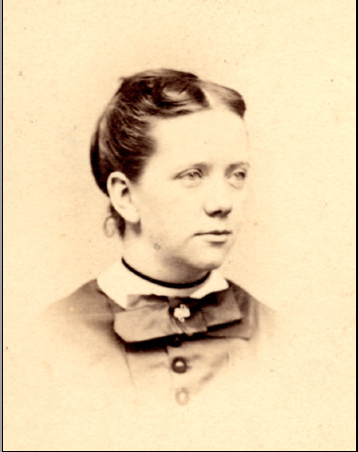Christine Ladd-Franklin was a pioneering American woman psychologist and mathematician. Though she completed a dissertation at John Hopkins University, the school would not grant women doctorate degrees at that time. Among her accomplishments, she was known for developing her own theory of color vision.

Christine Ladd-Franklin’s Early Life
Christine Ladd was born in Connecticut on December 1, 1847, and was the oldest of three children. Ladd’s mother, Augusta, and her aunt, Juliet Niles, were both firm supporters of women’s rights. As a young child, Ladd attended women’s rights lectures and other events with her mother.
Her mother passed away of pneumonia when she was just 12. At that time, Ladd went to live with her paternal grandmother. Her father eventually remarried and had two more children.
Educational Pursuits
Ladd had an early passion for education, which inspired her father to enroll her in a two-year co-ed program that included coursed designed to prepare boys for Ivy League universities. Ladd graduated from the program as valedictorian in 1865.
In 1866, Ladd enrolled at Vassar College and worked as a school teacher when she was not attending classes to help pay for school. Aided by a loan from her aunt, Ladd was able to continue her studies in mathematics.
She initially wanted to study physics but pursued math as the “next best subject” since women were not allowed to study or work in physics labs at that time. In addition to her aunt’s financial support, Ladd’s father also expressed considerable encouragement for her academic pursuits.
During the early years of her career, Ladd taught math and science courses in high schools in Pennsylvania, but expressed considerable disdain for teaching. In 1878, she enrolled at John Hopkins University, signing her application for a fellowship at “C. Ladd.”
The school awarded her the fellowship but tried to revoke it upon discovering that she was a woman. However, a professor named James J. Sylvester had been impressed by her contributions to an education journal and insisted that Ladd be allowed to keep the fellowship and become his student.
Ladd held her fellowship at John Hopkins for three years, but the school refused to print her name along with those of other fellows because they did not want to set a precedent of permitting women.
It was during this time that she began taking courses taught by experimental psychologist Charles Sanders Peirce, who became her thesis advisor. Thanks to these early studies, Ladd became the first woman to study psychology, mathematics, and logic at John Hopkins.
In 1882, Ladd married a fellow academic named Fabian Franklin, a faculty member in the math department at John Hopkins. They went on to have two children, one of which died in infancy.
Even though she completed all of the requirements for a Ph.D. in Mathematics and Logic, John Hopkins University refused to grant her the degree she had earned because she was a woman. It wasn’t until February 22, 1926, that the university finally awarded her the degree, 44 years after she had earned it. Ladd was 78 years old.
Christine Ladd-Franklin’s Career
In psychology, Ladd-Franklin is perhaps best known for her work in color vision. She traveled to Germany to study with researcher G. E. Muller and continue her research on color vision. She also later studied with Hermann von Helmholtz and Arthur Konig and rejected the trichromatic and opponent-process theories of color vision.
Instead, she proposed an evolutionary theory that involved three stages: black-white vision, blue-yellow vision, and red-green vision. Her theory’s emphasis on evolution is still considered relevant today.
Ladd-Franklin served as an editor and contributor to the Dictionary of Philosophy and Psychology and continued researching and writing on color vision. Despite her reputation in the field, she was never offered a formal academic position to continue her research.
Eventually, she obtained a position teaching one course per term (either math or logic) at John Hopkins, where she remained for five years. Later, she taught at Columbia, but again she was only allowed to teach one course each term, for which she was offered no faculty position or salary.
Selected Publications
- Ladd-Franklin, C. (1887). The experimental determination of the horopter. American Journal of Psychology, 1, 99-111.
- Ladd-Franklin. C. (1889). On some characteristics of symbolic logic. American Journal of Psychology, 2, 543-567.
- Ladd- Franklin, C. (1892). A new theory of light sensation. Proceedings of the International Congress of Experimental Psychology, London (pp. 103-108).
- Ladd-Franklin, C. (1896). The higher education for women. The Century, 53(2), 315-316.
- Ladd-Franklin, C. (1916). Review of an introduction to the study of color vision. Psychological Bulletin, 13(7), 272-275.
- Ladd-Franklin, C. (1923). Practical logic and color theories. Psychological Review, 29(3). 180-200.
- Ladd-Franklin, C. (1929). Colour and colour theories, New York, NY: Harcourt, Brace & Co.
Contributions to Psychology
Among her many accomplishments, Ladd-Franklin became one of the first two women elected to the American Psychological Association and one of only three female psychologists listed in James McKeen Cattell’s American Men of Science. Her academic interests were far-ranging, including psychology, logic, mathematics, and astronomy.
She wrote frequently on the sexism women faced in academics at that time and published numerous critiques of psychologist Edward Titchener for refusing to admit women to his all-male Society of Experimentalists.
Christine-Ladd Franklin died of pneumonia on March 5, 1930, at the age of 92. For her pioneering work, the Association for Women in Psychology established the Christine Ladd-Franklin Award in 1992.
Sources:
Furumoto, L. (1992). Joining separate spheres: Christine Ladd-Franklin, woman scientist (1847-1930). American Psychologist, 47, 175-182.
Furumoto, L. (1994). Christine Ladd-Franklin’s color theory: Strategy for claiming scientific authority? In H. E. Adler & R. W. Rieber (Eds.), Aspects of the history of psychology in America: 1892-1992 (pp. 91-100). New York: The New York Academy of Sciences.
Vaughn, K. (2010). Profile: Christine Ladd-Franklin. Feminist Voices in Psychology.
Vassar Historian. (2008). Christine Ladd-Franklin. Vassar Encyclopedia.
